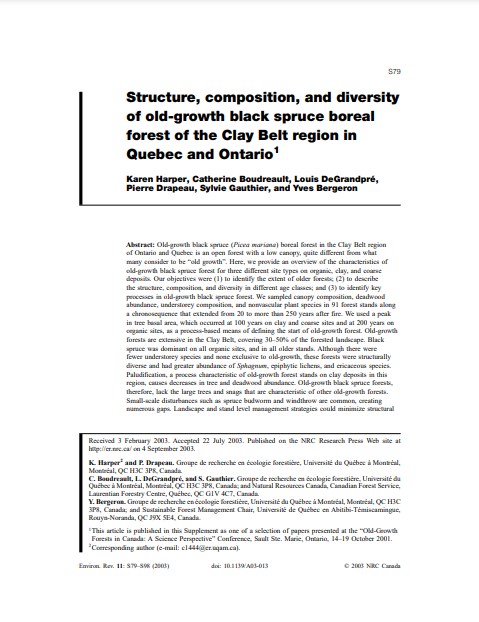Structure, composition, and diversity of old-growth black spruce boreal forest of the Clay Belt region in Quebec and Ontario
Bosque Modelo:
Lake Abitibi
Temática:
Conservación
Tipo de documento:
Artículo científico
Resumen
Old-growth black spruce (Picea mariana) boreal forest in the Clay Belt region of Ontario and Quebec is an open forest with a low canopy, quite different from what many consider to be “old growth”. Here, we provide an overview of the characteristics of old-growth black spruce forest for three different site types on organic, clay, and coarse deposits. Our objectives were (1) to identify the extent of older forests; (2) to describe the structure, composition, and diversity in different age classes; and (3) to identify key processes in old-growth black spruce forest. We sampled canopy composition, deadwood abundance, understorey composition, and nonvascular plant species in 91 forest stands along a chronosequence that extended from 20 to more than 250 years after fire. We used a peak in tree basal area, which occurred at 100 years on clay and coarse sites and at 200 years on organic sites, as a process-based means of defining the start of old-growth forest. Old-growth forests are extensive in the Clay Belt, covering 30–50% of the forested landscape. Black spruce was dominant on all organic sites, and in all older stands. Although there were fewer understorey species and none exclusive to old-growth, these forests were structurally diverse and had greater abundance of Sphagnum, epiphytic lichens, and ericaceous species. Paludification, a process characteristic of old-growth forest stands on clay deposits in this region, causes decreases in tree and deadwood abundance. Old-growth black spruce forests, therefore, lack the large trees and snags that are characteristic of other old-growth forests. Small-scale disturbances such as spruce budworm and windthrow are common, creating numerous gaps. Landscape and stand level management strategies could minimize structural changes caused by harvesting, but unmanaged forest in all stages of development must be preserved in order to conserve all the attributes of old-growth black spruce forest.
Información Bibliográfica
Autor:
Harper, K, C Boudreault, L DeGrandpré, P Drapeau, S Gauthier and Y Bergeron.
Revista:
Environmental Reviews
Año:
2003
N°:
1
País :
Canadá
Páginas:
79 - 98
Volumen:
11
Idioma:
Ingles
Palabras claves
boreal forest, old growth, paludification, Picea mariana, structural development, succession.





